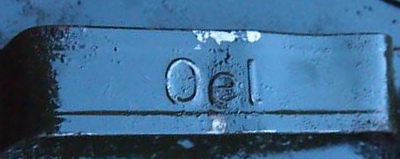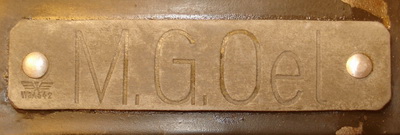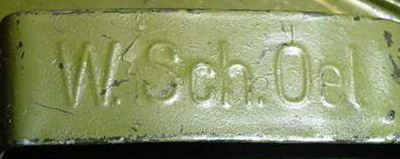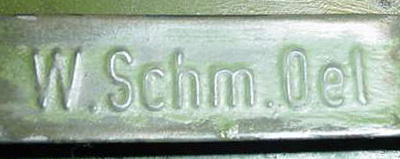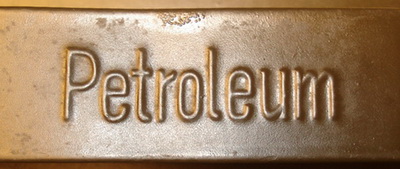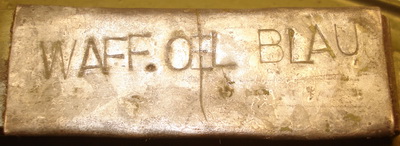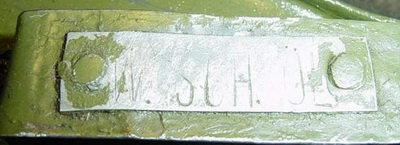

 MG34
& MG42 Petroleums Kasten MG34
& MG42 Petroleums Kasten  |
|---|
The MG34
& MG42 was issued with a wide
variety of equipment and accessories, often carried in the
Patronenkasten für MG. In this article I will focus on the
P-Kasten. Thanks to Vidar Andresen for the contribution of items, and Folke Myrvang and Sven Hein for photos. A special thanks to Stephane Arquille, the author of the book about Wehrmacht Kanisters (http://sdkfz7.free.fr/), who helped me solve the mystery about the Fischer logo. To ensure continuous and trouble-free operation of any gun, all operators know the importance of maintenance. In addition, especially for the MG34, lubrication was essential. A small bottle of oil was part of the gunner's belt pouch. But for the larger cleaning and lubrication jobs, a Patronenkasten für MG containing one can of Petroleum and one can of Öl was provided. 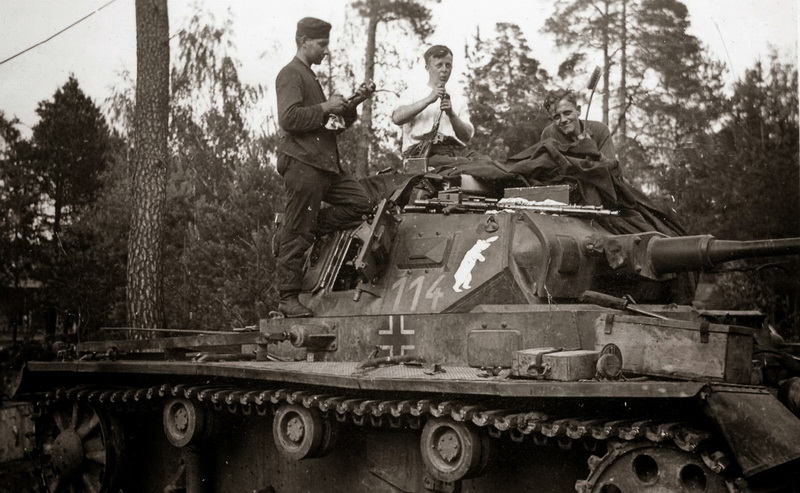 Panzerkampfwagen III undergoing weapons maintenance. There is a MG34 mit Panzermantel beside a standard MG34 on the roof, but the main point of attraction in this picture is the Ölbehälter in front of the person in the center. 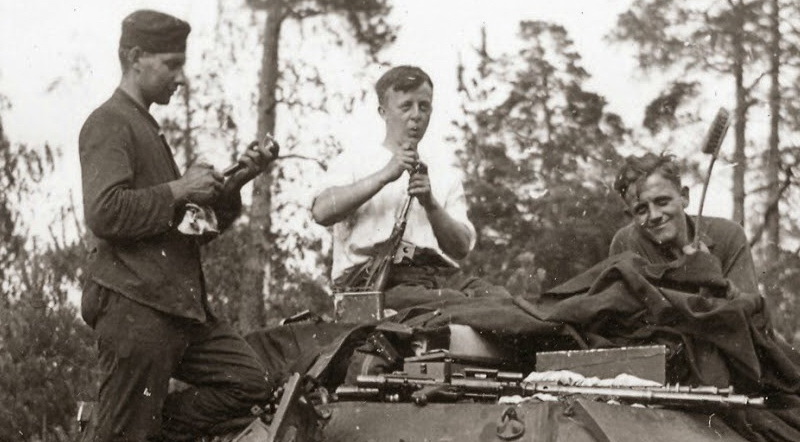 Also worth noting is the brush held by the person to the right in the picture. It looks like a bathtub back scrubber! The soldier in the center is cleaning a MP38. The Patronenkasten für MG 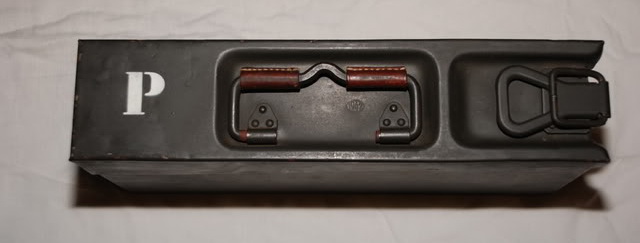 The container for the cans was a standard ammunition box, and both the early aluminum and the later steel cans could be used. The can was normally marked with a large stenciled "P", but a variety of other improvised marking methods can be found. The norm would be to paint the markings on the top, but sometimes the same markings were added to the end of the box. From the Dienstvorschrift 124/1 MG34 manual  The following accessories belongs to the MG.34: Ammunition box for LMG for the following uses: e) Box for the Oil and Kerosene can A "Wasserfund". (An item that has been submerged in water and reclaimed in modern times). Typical for a Wasserfund the paintwork has darkened considerably and bubbles in the paintwork have been formed. The box above is marked with "Öl. P" on top, and has "ÖL u. P." at the end. 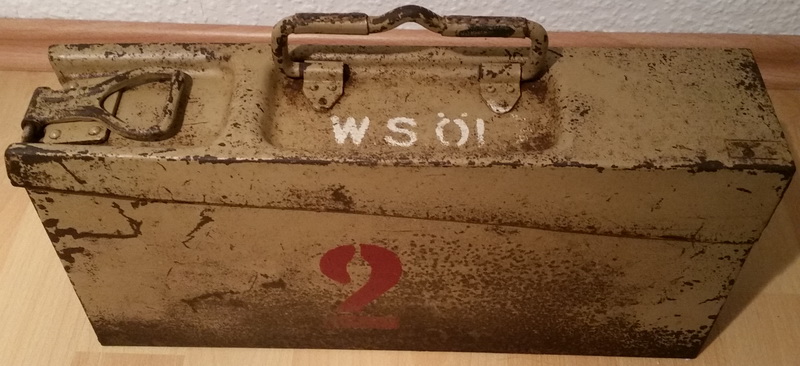 Yet another variety. "W S ÖL" stands for Waffen Schmier Öl - Weapons Lubricating Oil Picture courtesy of Sven Hein 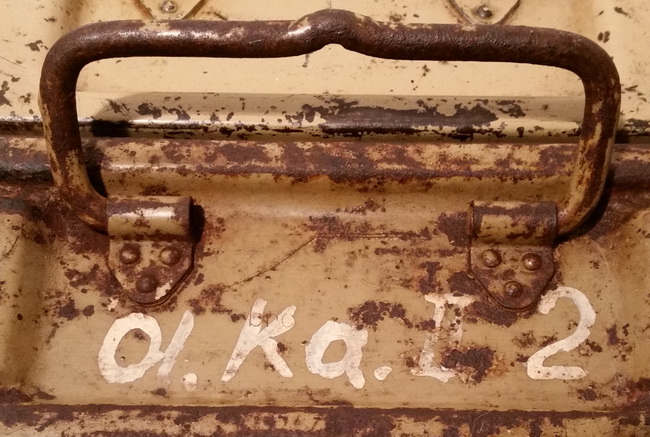 And another. "öl.Ka. II 2" probably stands for "Öl Kasten II 2" - Oil Cans belonging to unit II/2. Picture courtesy of Sven Hein 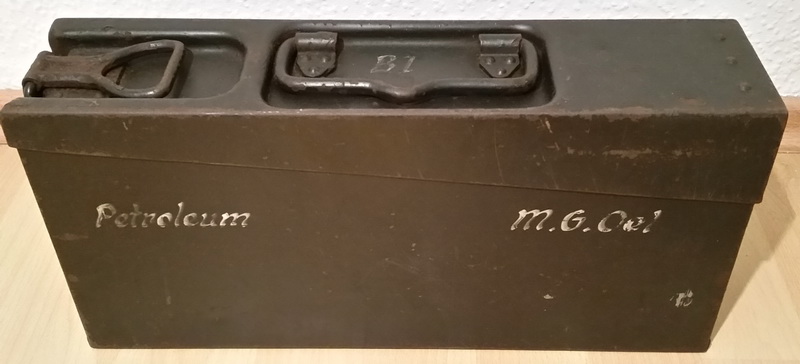 And yet another variety. This box has been labeled on the outside to mirror the cans in the interior. Picture courtesy of Sven Hein 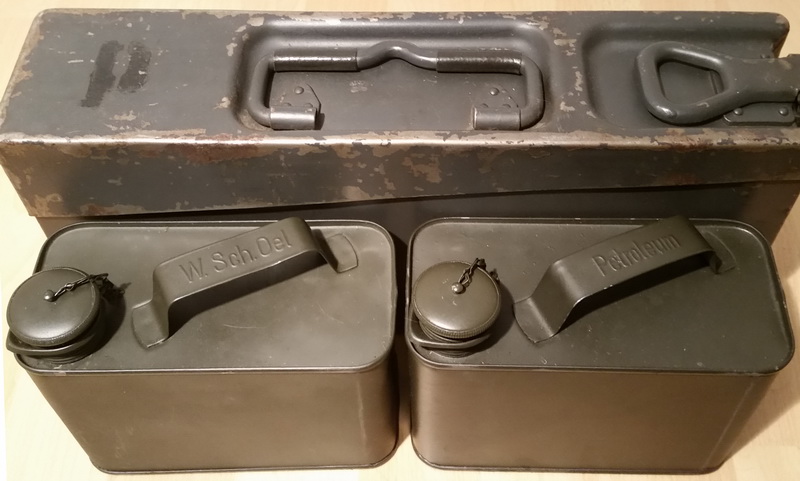 Picture courtesy of Sven Hein 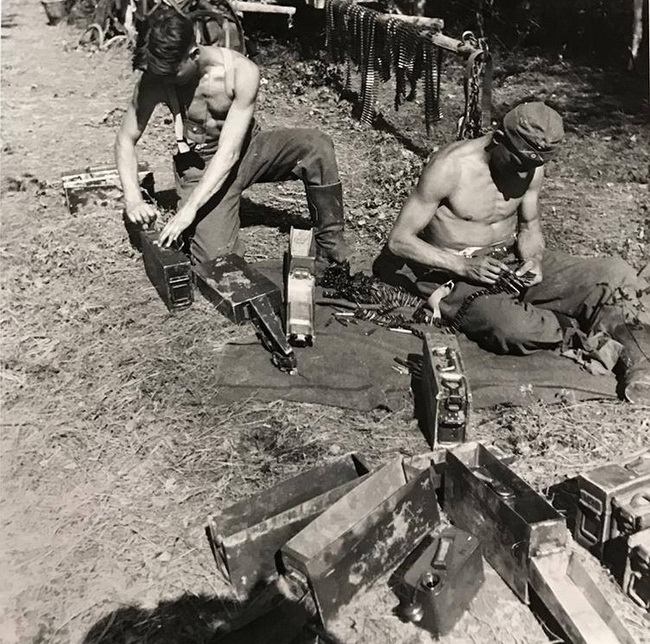 The P-Kasten in use. (Picture courtesy of Jim Kindred) The wood insert Several boxes have been found with an insert made from a piece of wood. It is shaped to fit in the bottom of the box, and would act as an absorbent for oil-spills and prevent the cans from rubbing against the bottom. I suspect there must have been a "Heeresmitteilung" or a "Von der Front für der Front" instruction on how to make these, but I have never seen one.  Picture courtesy of Sven Hein  Picture courtesy of Sven Hein Öl- und Petroleumbehälter (Oil and Kerosene can) These were all part of my study group in order to understand the can and it's differences! 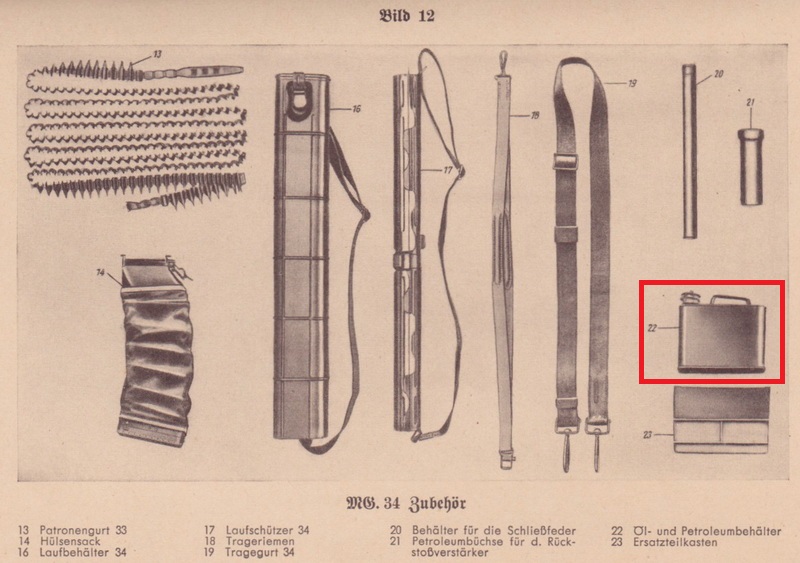 The Öl- und Petroleumbehälter as pictured in the 1941 edition of the Dienstvorschrift 124/1 MG34  22. Oil or Kerosene can The oil or Kerosene can 22 will store 1,25 liter of weapons lubrication oil or the same amount of Kerosene. The area of use for the individual can will be identified by a sheet metal tag with the abbreviations W.R.Öl, W.Schm.Öl or Petr. that has been riveted to the handle. Two Oil or Kerosene cans can be carried in one Ammunition box for LMG. The norm was one can of Öl and one can of Petroleum. The actual body of the can is constructed from 3 separate pieces crimped together; top plate, bottom plate and body section. The oil and kerosene cans are identical in appearance, and can only be separated by their tags or markings on the handle. The can opening is a combination of a funnel and a spout, and is also threaded for the screw cap. Opposite of the spout the edge has been pressed flat with an eyelet. This is used to secure the chain that holds the screw cap. The screw cap is formed from two pieces, the body with the threads and a domed disk that is crimped on to the top. The top disk is fitted with a stud that holds the chain. A gasket is glued in place at the bottom of the cap and ensures a tight fit against the bottom of the funnel (on some variations the gasket is seated in the bottom of the funnel). The handle is welded to the top plate. Early versions had a magnesium/Elektron tag riveted to the handle denoting the contents. Later versions had the text embossed directly into the handle to save work and raw materials. The makers mark, and sometimes the WaA can be found on the end of the handle. On early versions it was impressed and later versions had it embossed. Differences and development The cans all appear to be identical at first glance. The only difference I can find is in the handle and screw cap, not taking the markings into account.  Two different makers with different design for the handles.  Another two with different handle profiles; one smooth and one crimped around with two ridges.  Manufacturer's variations on the screw cap. Note height of top disk; some made them more "domed". 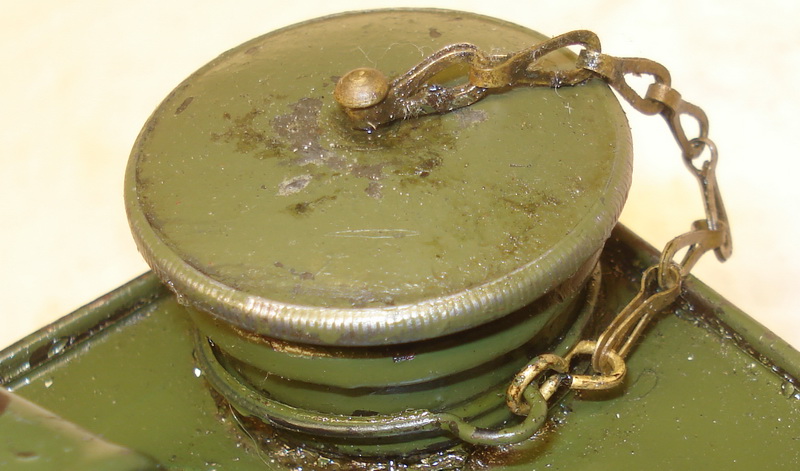 A variation of the chain attachment. This maker used a ring that was crimped in place, allowing it to travel around the funnel. 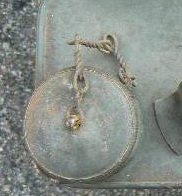 The only sign of "development" I have found is the chain attached to the screw cap. The chain seems to change from "non-magnetic" to iron, and then later in the war to a much simplified twisted-thread type. 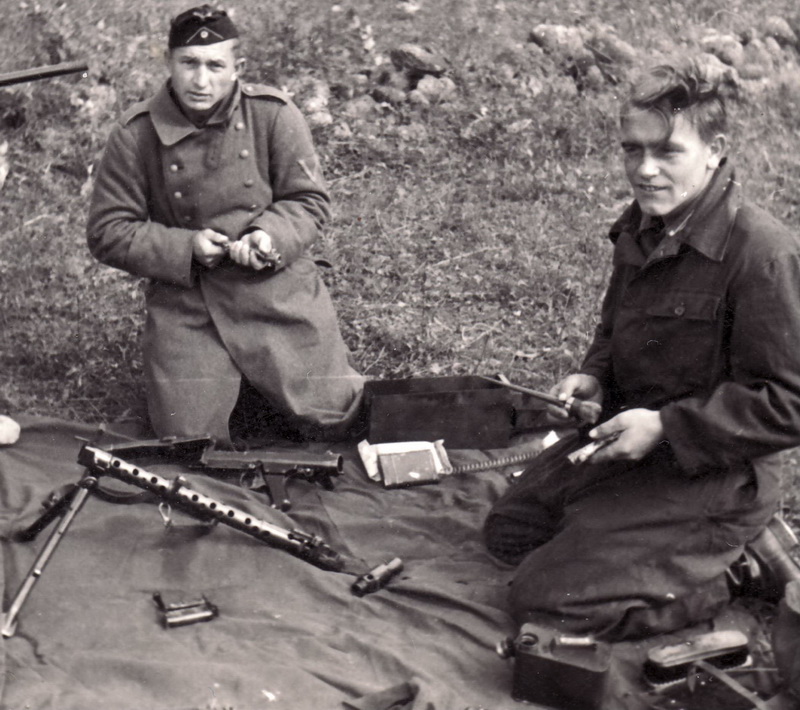 A pair of tankers cleaning a standard infantry MG34. Note the oil can by the right man's left knee, the shoe brushes to the right of the can, and the brush in his hand. Also visible in the center of the photo is a standard RG34 cleaning kit. Picture courtesy of Folke Myrvang. Paintwork There seems to have been three different versions of finish applied to the cans. 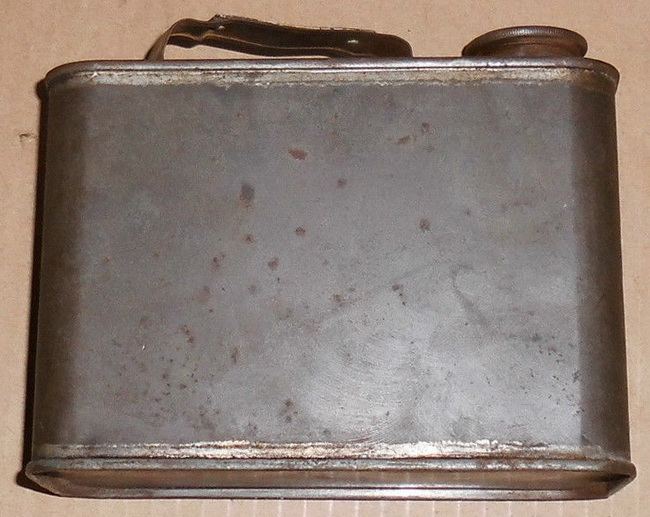 The prewar cans had no paint applied at all, but were instead zinc-plated to prevent corrosion.  Cans manufactured for the "war-effort" came in shades of dark green - Olive Drab. 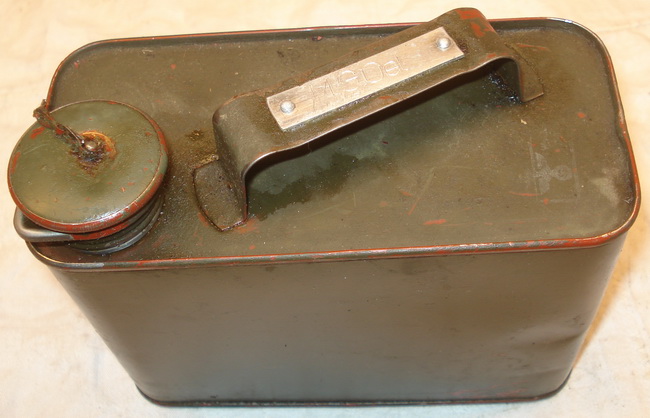 Normally the paint was applied directly to the bare metal. This can made by Braunschweigische Blechwarenfabrik GmbH is the only example I have observed with a red primer present. Note the white ink WaA! 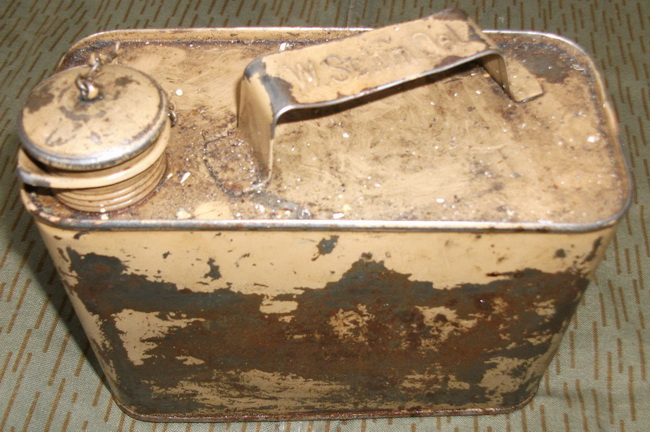 Kallenbach, Meyer & Franke Metallwarenfabrik, Luckenwalde (cjs) manufactured cans towards the end of the war in the Dunkelgelb (dark yellow) Einhetsfarbe. This can is in fact the only example observed that has been factory painted in this color. Update This can was sold on Ebay, and is a very early Reichswehr version, probably made for the MG13. 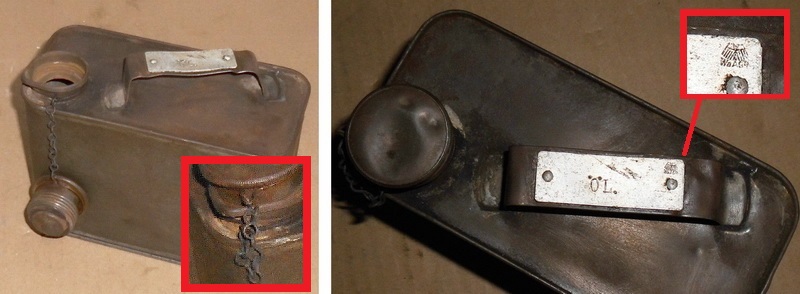 It has a blank tag riveted to the handle with a Reichswehr WaA marking. The tag is slightly higher than the later versions, and it has been marked with the letters "Öl." by the unit Waffenmeister. The can itself has not been painted, but is zinc-plated. The chain is mounted to a revolving ring on the screw cap and through a hole beside the spout. The actual chain is also different from later models. There is no rivet on the top of the screw cap to hold the chain. The contents marking Öl 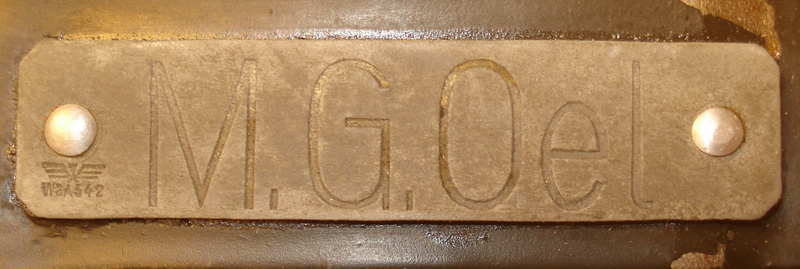 The first can was supposed to contain Öl, or Oil. This is not as straightforward as one might think though. In German, the letter "Ö" is sometimes substituted with "oe", so Öl and Oel is the same word. Then it clouds over, as the manufacturers of the cans used different definitions or descriptions for the contents. Maker marked versions on the handle includes:
Especially the MG34 was a finely-tuned piece of machinery where proper lubrication was essential for flawless operation. The early oils must have been less effective as lubricants, as a separate container for a lubricating additive was issued in the gunners pouch; the sulphur container (Streubüchse für Schwefelblüte). By 1941 it was already removed from the manual for the MG34, so I guess that oils with better lubricating qualities had been developed. Petroleum 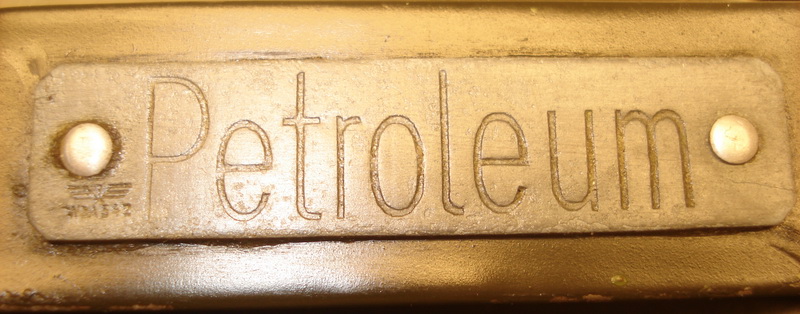 The second can was supposed to contain Petroleum. Petroleum was the German equivalent of Kerosene (or Paraffin). The main use for the Petroleum was cleaning of the weapon parts after shooting. Some of it was used to fill up the special can in the Ergänzungskasten, the "Petroleumsbüchse für d. Ruckstoßverstärker", the soaking can. 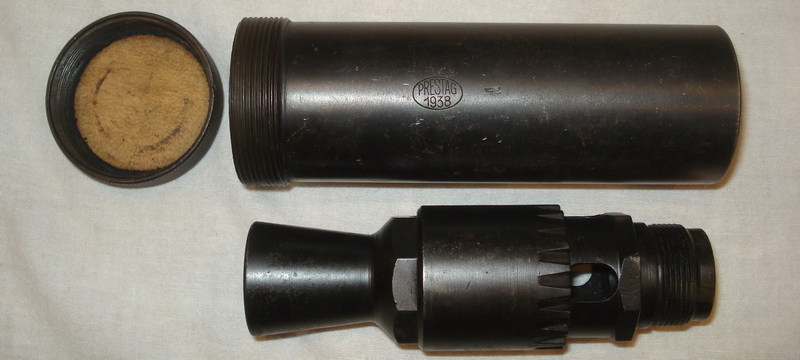 This can would be left over night with the recoil booster and flash-hider all drenched in kerosene. 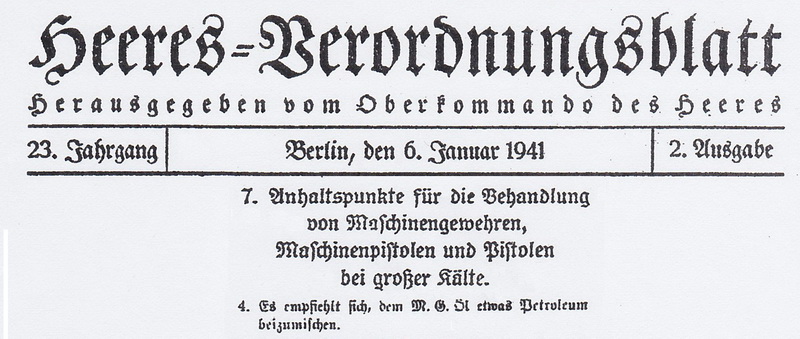 In the event of extreme cold it was suggested to dillute the gun oil with kerosene. Markings The markings on the cans can be divided into three categories. The contents, the maker mark/date and the WaA. In addition different units marked their cans with paint. Official contents markings
Unit applied contents markings
Makers, marks and date The standard position for the makers mark is at the end of the handle. The following makers have been identified
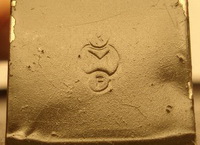 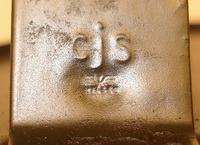 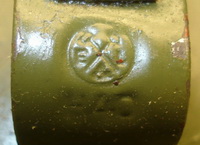 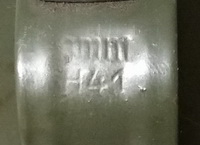 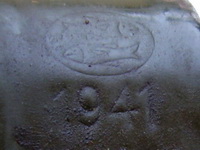 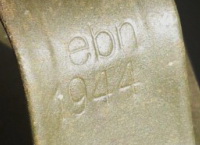 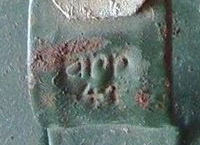 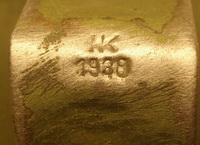 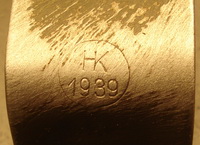 Most makers dated their products with 2 or 4 digits directly together with their company logo or code. The capital "H" that stands in front of the date on cans manufactured by Eckardt & Lohkamp is an abbreviation for "HEER". This marking can commonly be found on "desirable" items for civilian use, like hand tools, spades, saws, pickaxes etc. 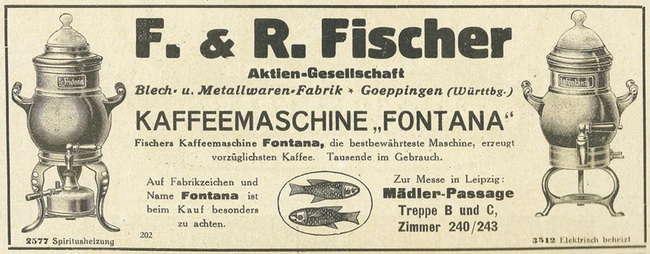 A prewar newspaper-add from the company F. & R. Fischer Blech und Metallwarenfabrik Göppingen. Note the company logo, the oval with fish inside, still in use on their cans in 1943. cjs seems to be the biggest maker by far judging from surviving examples, but didn't date their products. It is still possible to sort them out in regards to early-mid-late.  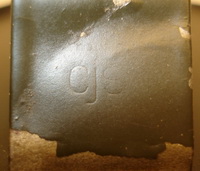  Early cans had the impressed logo, then the impressed code was used (1940'ish), and the last version was the embossed code.  The letter-head from Braunschweigische Blechwarenfabrik GmbH (arr). Their logo has not been observed on any cans, so I presume they didn't start production until the manufacturers codes were in place in 1940. The Waffen Amt Abzeichen The Waffen Amt acceptance mark was impressed in the same position as the makers mark, with some exceptions.  The early cjs cans had a separate zinc plate denoting the contents riveted to the handle. This carried the WaA for the can in the lower left corner. When this practice was discontinued and the text and code was embossed into the handle instead, the WaA was impressed below the code.  Note how the code is embossed, and the WaA impressed on the finished and approved product. 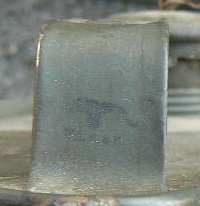 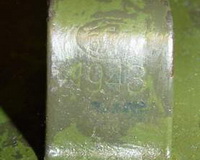 Some makers used ink and applied the WaA in the same position. 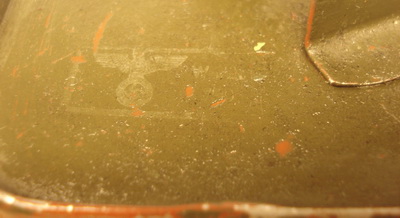 Yet another version, in white ink, this time by Braunschweigische Blechwarenfabrik GmbH. This is also the only maker that used a red primer underneath the paint. 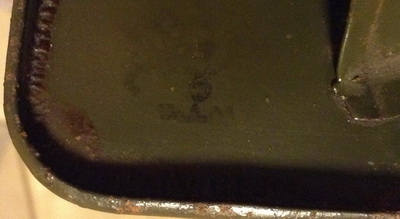 Picture courtesy by John Aa. 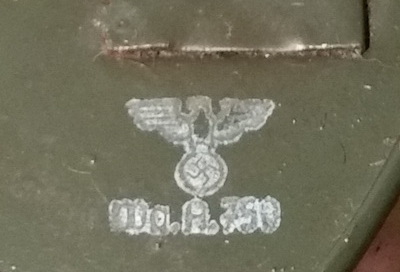 Picture courtesy of Sven Hein Cans marked by the units Some units added extra markings to their cans in order to improve the chances of picking the right one, or prevent loss. 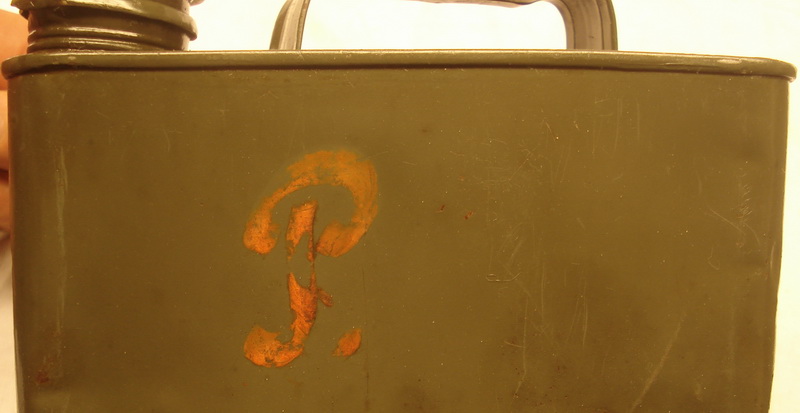 This Petroleum can have had a red "P" painted to the side for better identification. 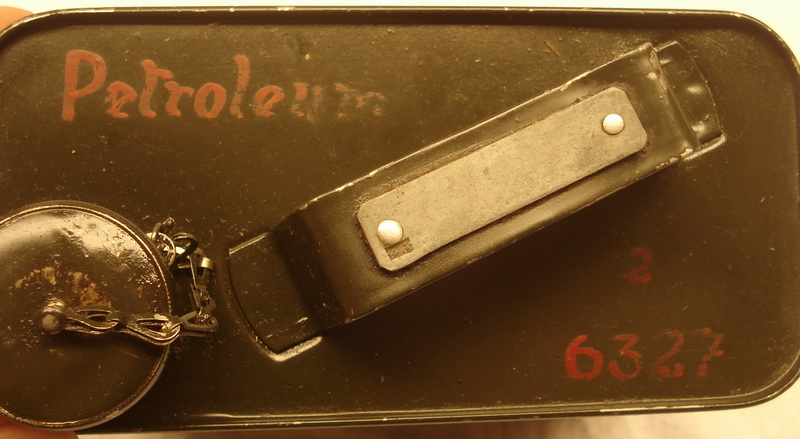 This Petroleum can was a factory "blank", but instead of engraving, the unit chose to paint on "Petroleum". "2" might be a unit reference, and "6327" most probably a weapons serial number (it is not a Feldpostnumber). 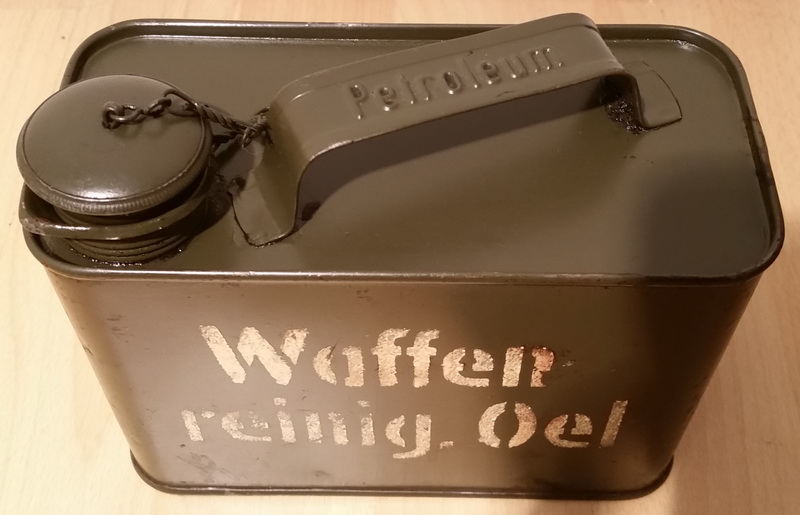 A can with "wrong" contents! It came from the factory marked as a Kerosene can, but was altered by the unit to contain Oil. Note the late version chain for the screw cap. Picture courtesy by Sven Hein. 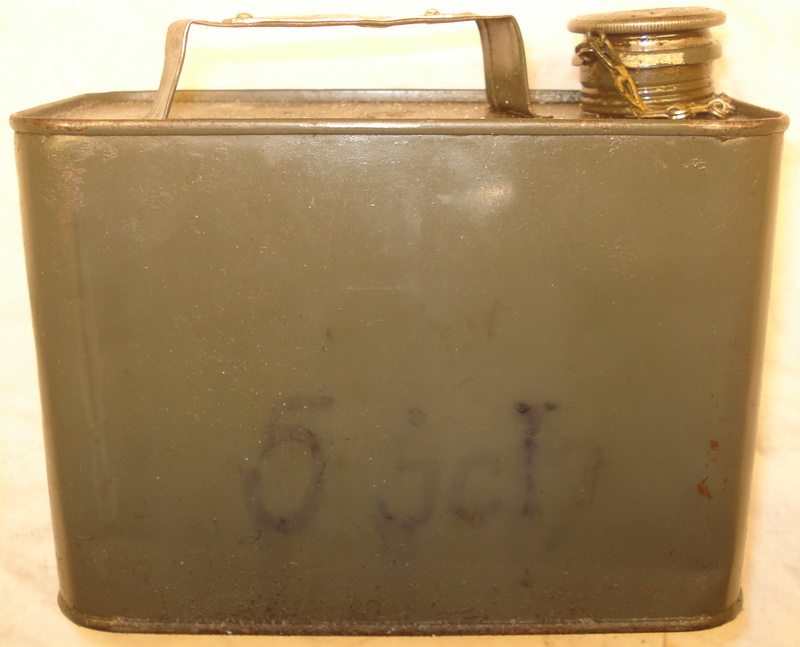 This one is still a mystery. It is marked "5 Sch" on the side panel. Might be an abbreviation for "5 Schützenkompanie", but this is still somewhat unclear. Other users The Third Reich exported a batch of approximately 1000 MG34s to Portugal in 1943 -1944. They also sold a quantity of MG13 to Portugal in the pre-war years. These weapons came with the standard accessories, also the Petroleumskasten. 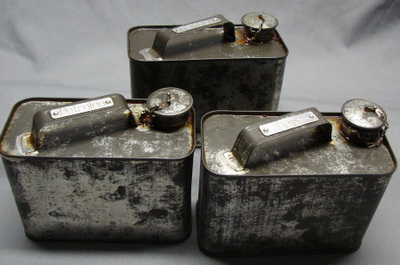 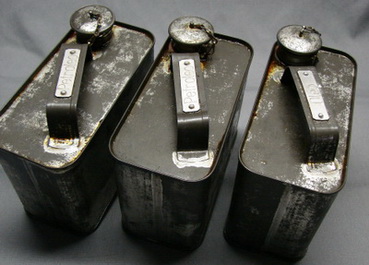 These cans are unpainted, most probably coated with zinc. They are tagged "Oleo" and "Petroleo". It is not known if these markings were done in Germany or in Portugal. From the finish they are assumed to be from the MG13 contract. 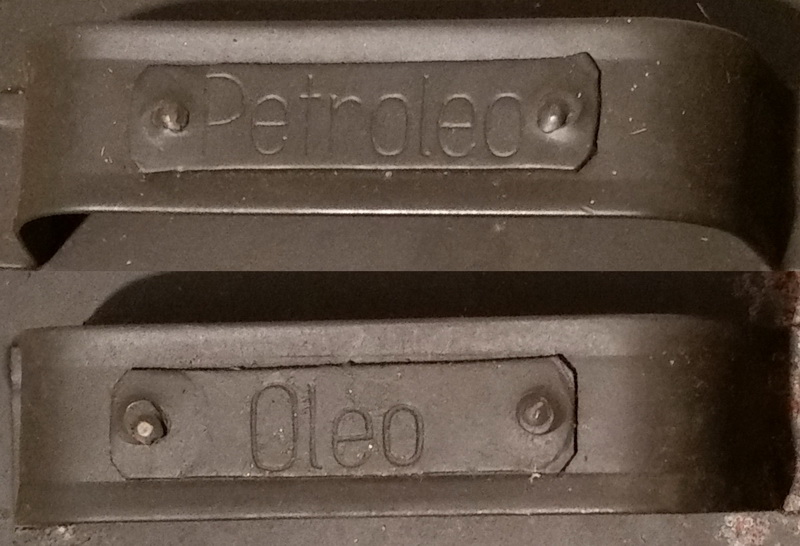 Another set of Portuguese cans. These cans were made by a different maker than the ones above. Note the shabby form of the tags and rivets. Most probably changed by the Portuguese. The tags were painted together with the cans. Picture courtesy Sven Hein. 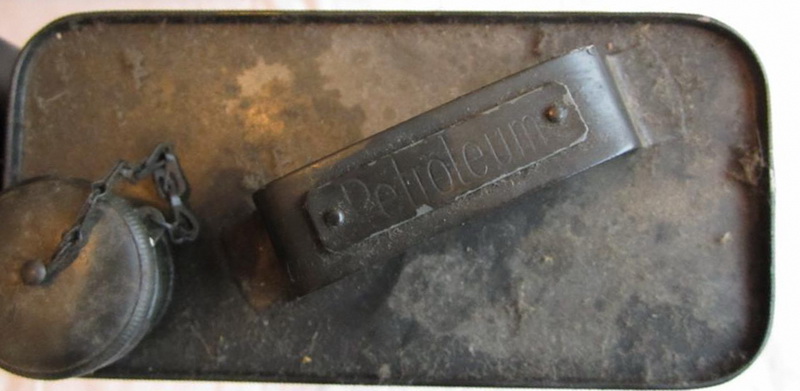 There is also a second version that could be from the Portuguese MG34 contract. They are painted darker than usual, they have turned up in numbers, and all have the original German labels with WaA that are covered in the same paint as the can. The labels were never painted by the Germans, as they were always riveted on after the paint job, so I suspect that the paint job is "post-German". 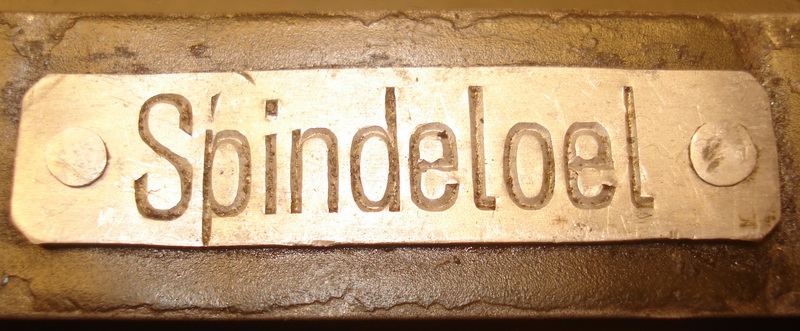 The can could also be useful for other types of machinery. This can is marked "Spindeloel" for Spindle Oil, special oil used on a lathe during manufacturing. It was most probably diverted from its intended use as a MG accessory to a Waffenmeister's workshop.  Brake Fluid, yet another alternative area of use.  Brake oil, yet another oddity! This must have been a substance for a very special function as one would seldom need to lubricate the breaks..... 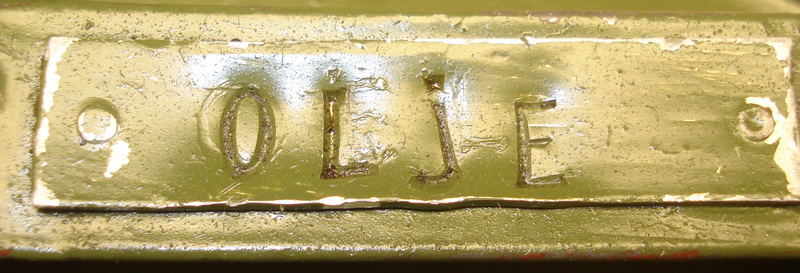 A can that has been reused, repainted and remarked for the Norwegian army. "OLJE" means Oil in Norwegian. Note that the original German unit marked tag still has "OEL" visible. Most probably a wise move, as the German word "Öl" is the same as "Beer" in Norwegian. Postwar use Both Portugal and Norway continued to use the MG34 and its accessories after the war. As far as I know there are no cans of identical form manufactured postwar, so if what you find look like the above cans, you are good to go! 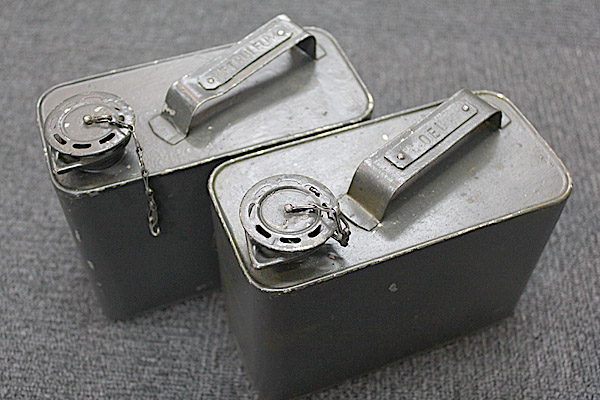 But I did find the above picture on the net. These cans have a very different screw cap, more pointy beaks on the spout and a much lower profile on the top edge. In addition, the handles appear to have been refitted with new, home-made contents labels with a fake WaA. My guess would be that they are Bundeswehr cans. 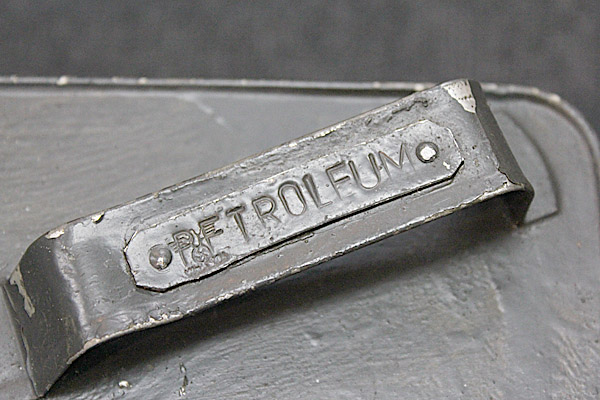 Home-made contents label with a fake WaA. Compare with the known originals above. 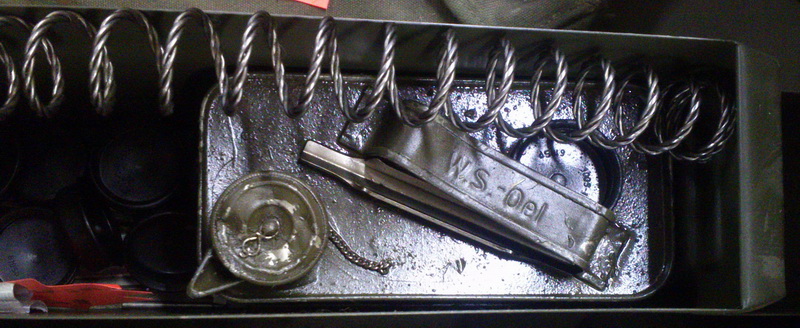 A current issue Bundeswehr can, pictured as part of a modern issue Ergänzungskasten. Note the new model chain, beak and screw cap. There is also a significant design change; the handle is now mounted at a different angle. Other alternatives A platoon ready to march. The row on the right is for accessory cans, the rest being for ammunition. The one closest to the camera on the right side row is a water can for the MG08. It was not unusual to reuse these as oil or kerosene cans.  A pair of MG08 water cans reused as oil and kerosene cans Picture courtesy of Sven Hein 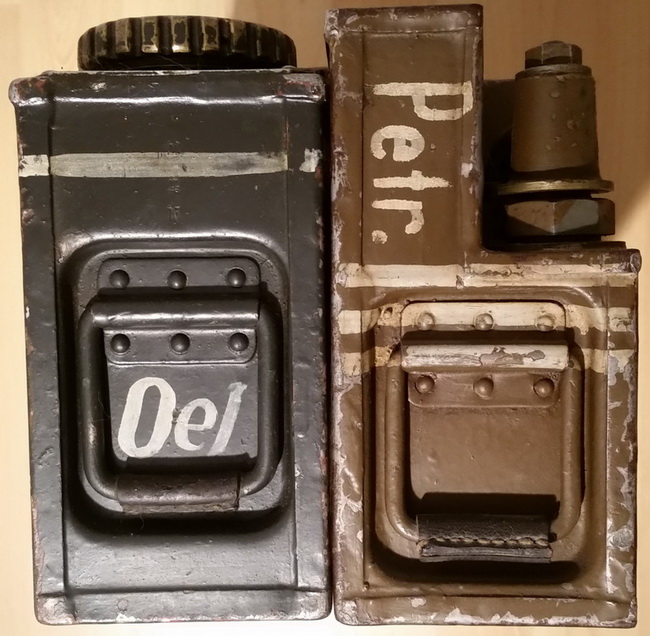 The white stripes have been added to ensure positive identification. 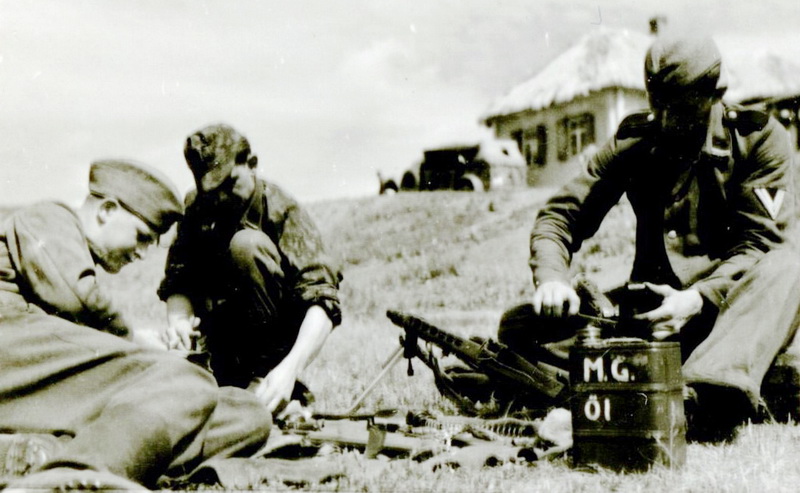 Any type of canister could of course be used, as long as the size was suitable. This photo was taken by SS-Propaganda Kompanie Kriegsberichter Büschel on the eastern front and shows SS men cleaning their MG42, using an alternative oil canister of a considerable size. Oddities 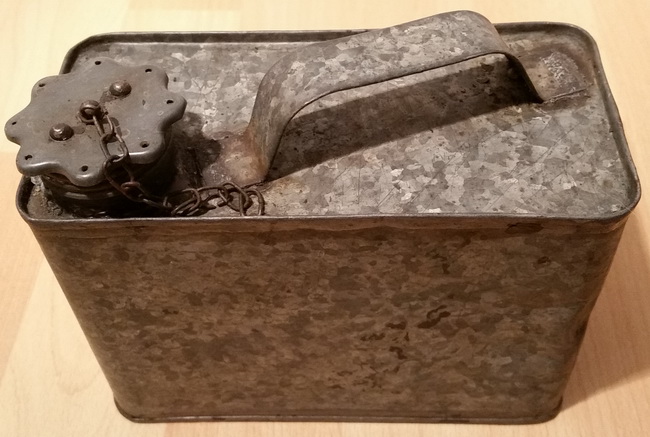 Picture courtesy of Sven Hein This can very much resembles the standard cans discussed above, but is clearly of an earlier date. Some traces of paintwork remain (see top of cap) but the zinc-coated steel is mostly "nude". The screw cap resembles the safety cap on the Stielhandgranate 15. My theory is that this can is a WW1, or very early Reichswehr can, and the forefather of the standard can. |
||||||||||||||||||||||||||||||||||||||||||||||||||||||||||||||
| Home | For sale | Site map | Contact information | Guest book |
